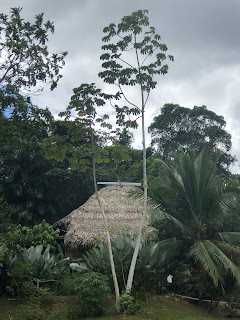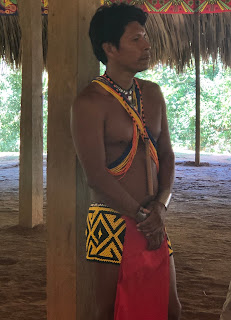At the end of the Amador Causeway sits Flamingo Island, and this is where our ship tendered to while at Anchor off Panama City. It’s the gateway to the Canal building zone, as well as Panama City itself. The Causeway itself was built during the construction of the Panama Canal to keep the swift currents from “silting up the Canal entrance.” Today it has a bio diversity museum, shops, restaurants, the cruise terminal, a swanky marina and a nice bike/walkway.
I chose to take a ship tour outside of town to an indigenous village where tribe of people called the Ambera live. They settled in this area from Colombia and in 1984 the government declared the area in which they had settled a National Park. Because of this, the Ambera were no longer allowed to hunt nor raise large crops on the land. We were told that in order for them to be able to survive they’d either have to leave or they could set their villages up to be a place for tourism. This way they could make ,one and then they could buy their food and their goods. Sounds fishy to me, but whatever. The good news is that they seem to have kept their basic way of life and they make beautiful crafts, especially woven products and wood carvings.
In the village we visited, there were about 20 families, making up a small population of 100. There is a chief, a spiritual shaman, a medicinal healer. They are very kind and gentle people. Their village gets about 25% of what we pay for our tour, and they go Venus a talk on how they live, translated by our tour guide. They fed us a nice snack of fried tilapia and plantains. The younger men and women demonstrated one of their ceremonial dances. Each family also set up a table to display their crafts. Whatever money they made from selling was that family’s to keep.
It was a nice day. They live about a ten minute motored canoe ride up a river, about 90 minutes outside of Panama City. I didn’t see any satellite dishes on their thatched roof houses, nor did I see any smartphones. I think they mostly keep to themselves. The kids are taught on site by a two teachers that come in from Panama City and they go to class until 6th grade. After that it is up to the student and their family if they want to continue their education. If they do, the family needs to pay to send them to the city for further learning. Their language is unique and is all oral, although in recent years they have been starting to re-create the language in written form, before it is lost forever. The elders in the villages are helping with this.
















No comments:
Post a Comment